Kata Tjuta – Valley of the Winds
Hi There,
The next day dawned bright and not a cloud in sight, a bit different from yesterdays weather at Uluru(see part 11). Todays adventure was being held at Kata Tjuta aka the Olga’s. Another amazing landform not far from Uluru with rich cultural attachments for the local people.

Kata Tjuta is Pitjantjatjara meaning ‘many heads’, clearly evident in the above photo how they got to that name! More formally you would describe it as an imposing series of mounds and domes that rise out of the surrounding landscape to an astonishing height of 546 metres above the plane(or 1066 metres above sea level). That’s a staggering 200 metres(roughly) taller than Uluru(Ayres Rock), yet I don’t think it is as well-known as Uluru. I suppose the difference is you can’t climb Kata Tjuta whereas you can Uluru occasionally! What is it with us white fella’s wanting to climb and stomp over everything anyway… I digress, there will be no more political leanings or thoughts from now on! As is the case with Uluru, these rock formations are just the tip of a huge slab of conglomerate that may extend up to 6 kilometres underground. What is conglomerate? I will get to that later!
 These two photos were taken from the dune viewing area where there were some interesting plants to check out as well, always a good thing.
These two photos were taken from the dune viewing area where there were some interesting plants to check out as well, always a good thing.
 This is the Broad leaf Parakeelya, Calandrinia balonensis, an annual or perennial growing to 30cm either way with a basal rosette of fleshy linear to lanceolate leaves up to 10 cm long and 1 cm wide. A good indicator plant of recent good rain, if there’s a good number and they are of a good size-this indicates recent good rain as they grow rapidly during wet seasons and store water for the dry times. It has a small purple poppy like flower on tallish stems that dance around in the breeze, if there is one!
This is the Broad leaf Parakeelya, Calandrinia balonensis, an annual or perennial growing to 30cm either way with a basal rosette of fleshy linear to lanceolate leaves up to 10 cm long and 1 cm wide. A good indicator plant of recent good rain, if there’s a good number and they are of a good size-this indicates recent good rain as they grow rapidly during wet seasons and store water for the dry times. It has a small purple poppy like flower on tallish stems that dance around in the breeze, if there is one!

Also from the dune viewing platform, you can swivel 90 degrees to the right and this is what you see below.
 The only other imposing rock that’s around here! The tree’s you see in the distance are Desert Oak, Allocasuarina decaisneana , also look at the first two photos of this post, the majority are all Desert Oak, quite common across the spinifex grasslands. Juvenile Desert Oak are quite different in appearance compared to mature examples. More will be revealed about these trees in a future post! Now lets head off and have a look at this place.
The only other imposing rock that’s around here! The tree’s you see in the distance are Desert Oak, Allocasuarina decaisneana , also look at the first two photos of this post, the majority are all Desert Oak, quite common across the spinifex grasslands. Juvenile Desert Oak are quite different in appearance compared to mature examples. More will be revealed about these trees in a future post! Now lets head off and have a look at this place.
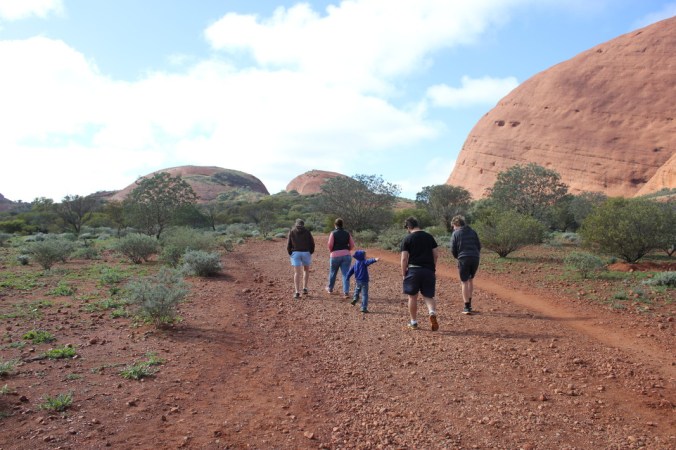
 Kata Tjuta is a Anangu mens site and sacred under traditional law, which means for us tourists there is no wandering off the pathways. There are plenty of different walks here and lots to see, so as we meander along, please stay with me! No wandering off! Note in the above photo the puddle of water which is a byproduct of rain we had here the day before. If you have read part 11 of this series you would realise this, but now we were enjoying the crisp sunshine, it is winter by the way! A balmy 17 degrees Celsius! You can see a bunch of people above, and to their left a green patch. I will concentrate on that now, the patch that is.
Kata Tjuta is a Anangu mens site and sacred under traditional law, which means for us tourists there is no wandering off the pathways. There are plenty of different walks here and lots to see, so as we meander along, please stay with me! No wandering off! Note in the above photo the puddle of water which is a byproduct of rain we had here the day before. If you have read part 11 of this series you would realise this, but now we were enjoying the crisp sunshine, it is winter by the way! A balmy 17 degrees Celsius! You can see a bunch of people above, and to their left a green patch. I will concentrate on that now, the patch that is.
 Here’s that green patch. Wanderrie grass , Eriachne scleranthoides , a very rare type of grass, see quote from Grasses of Australia, “Known from two localities in SW central Australia. Conglomerate monoliths (Mt Olga and Mt Currie) growing on crests, scree slopes, in chasms and crevices, in shallow sand, gravelly slopes or shallow stony red soil, sometimes in seepage from
Here’s that green patch. Wanderrie grass , Eriachne scleranthoides , a very rare type of grass, see quote from Grasses of Australia, “Known from two localities in SW central Australia. Conglomerate monoliths (Mt Olga and Mt Currie) growing on crests, scree slopes, in chasms and crevices, in shallow sand, gravelly slopes or shallow stony red soil, sometimes in seepage from
massive boulders. Flowers May (late-autumn) and Aug.-Oct. (late-winter to mid-spring)”. Above we have a seepage area on a scree slope, which is where it likes to grow.
 Quite a sharp prickly grass, looks more shrub like though doesn’t it! Even closer below.
Quite a sharp prickly grass, looks more shrub like though doesn’t it! Even closer below.
 This is a problem I find, I get distracted by things off to the side of the pathway and lo and behold the next time I look up the family is gone!! I’m sure I’ll catch them somewhere.
This is a problem I find, I get distracted by things off to the side of the pathway and lo and behold the next time I look up the family is gone!! I’m sure I’ll catch them somewhere.


The remarkable thing about Kata Tjuta is that it’s composed of a different type of rock than what Uluru(made of sandstone) is which is only 50 kilometres away(by road, 32 as the crow flies). Katu Tjuta is a conglomerate, a gravel consisting of pebbles, boulders and cobbles cemented by sand and mud. Conglomerate is also a sedimentary type rock. From a distance Kata Tjuta looks like the other big rock just around the corner, but up close its quite rough, see below photo.
 Don’t know why, but I found this quite fascinating. Here in the middle of no where, the only two objects that rise above the plain separated by a mere 50 kilometres are made of completely different rock. I’m sure this happens everywhere, but I just found it fascinating.. Click HERE for more geology information on this rock formation. If this was originally a huge slab of rock, how did it become domes and valleys? This is likely to be mechanical erosion of sand from the rock and other chemical erosion caused by moisture. The major Valley may have been fractured from the time of the Alice Springs Orogeny. Chemical weathering due to ground water widened the fissures and rainwater run off gradually formed the domes and canyons we now see.
Don’t know why, but I found this quite fascinating. Here in the middle of no where, the only two objects that rise above the plain separated by a mere 50 kilometres are made of completely different rock. I’m sure this happens everywhere, but I just found it fascinating.. Click HERE for more geology information on this rock formation. If this was originally a huge slab of rock, how did it become domes and valleys? This is likely to be mechanical erosion of sand from the rock and other chemical erosion caused by moisture. The major Valley may have been fractured from the time of the Alice Springs Orogeny. Chemical weathering due to ground water widened the fissures and rainwater run off gradually formed the domes and canyons we now see.
 Now for some more wildflowers. Look at that patch of Pussytails, Ptilotis.
Now for some more wildflowers. Look at that patch of Pussytails, Ptilotis.

Closer view here. This is actually Hairy Mulla Mulla, Ptilotus helipteroides . The stems and leaves have a persistent covering of medium to dense hairs, giving it its common name.
 It is an annual herb growing to about 50cm and usually occurs on rocky or gravelly ranges, hills or rises and on acidic rock and also found in Mulga dominated red plains and other locations.
It is an annual herb growing to about 50cm and usually occurs on rocky or gravelly ranges, hills or rises and on acidic rock and also found in Mulga dominated red plains and other locations.
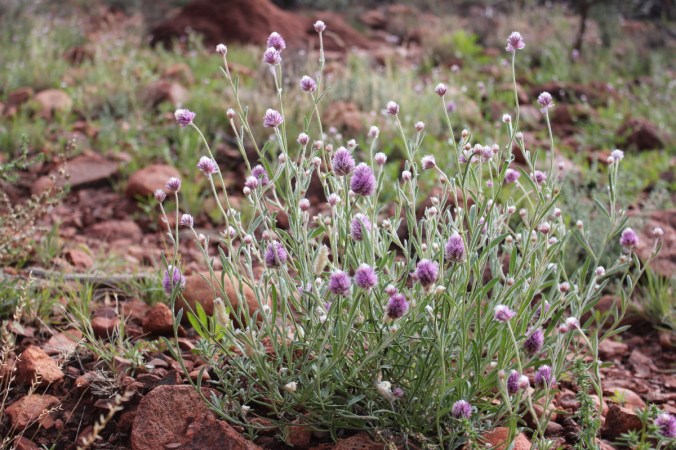
Flowering from June until November, now for a real close-up!
 We were heading to the Valley of the Winds and eventually the Karingana lookout, a return trip of 2.5 hours on a grade 4 – difficult track according to the visitor guide. I think it was more in line with moderate track! Here we are well into the Valley of the Winds and yes it was slightly breezy here!
We were heading to the Valley of the Winds and eventually the Karingana lookout, a return trip of 2.5 hours on a grade 4 – difficult track according to the visitor guide. I think it was more in line with moderate track! Here we are well into the Valley of the Winds and yes it was slightly breezy here!
 It’s at this point in the above photo that if the temperature is over 36 deg Celsius at 11am, the track is closed. This is the Karu Lookout, impressive to say the last. Those mounds in the distance look like a flight of stairs, sort of!
It’s at this point in the above photo that if the temperature is over 36 deg Celsius at 11am, the track is closed. This is the Karu Lookout, impressive to say the last. Those mounds in the distance look like a flight of stairs, sort of!
 As you can see it is quite rocky here.
As you can see it is quite rocky here.
 Nothing amazing with the above photo, just showing more rock and more conglomerate, you can also see water seeping out from under that large slab. Below is a swathe of Hairy Mulla Mulla, quite impressive to see it like this in its natural environment.
Nothing amazing with the above photo, just showing more rock and more conglomerate, you can also see water seeping out from under that large slab. Below is a swathe of Hairy Mulla Mulla, quite impressive to see it like this in its natural environment.

 Again not a great photo but it just shows a lovely natural garden bed with no human influence! I read something recently which I hadn’t really thought of before and that was someone’s thought on grouping colours in the garden as we do, pastels here, bright hot colours over there and so on. The thought was (not exactly in these words)”Nature doesn’t separate plants into colour groupings, so I’m not going too. There is just a riot of colour throughout my garden”. I really liked that and it may just become my new mantra. Not sure what the old mantra was!!
Again not a great photo but it just shows a lovely natural garden bed with no human influence! I read something recently which I hadn’t really thought of before and that was someone’s thought on grouping colours in the garden as we do, pastels here, bright hot colours over there and so on. The thought was (not exactly in these words)”Nature doesn’t separate plants into colour groupings, so I’m not going too. There is just a riot of colour throughout my garden”. I really liked that and it may just become my new mantra. Not sure what the old mantra was!!

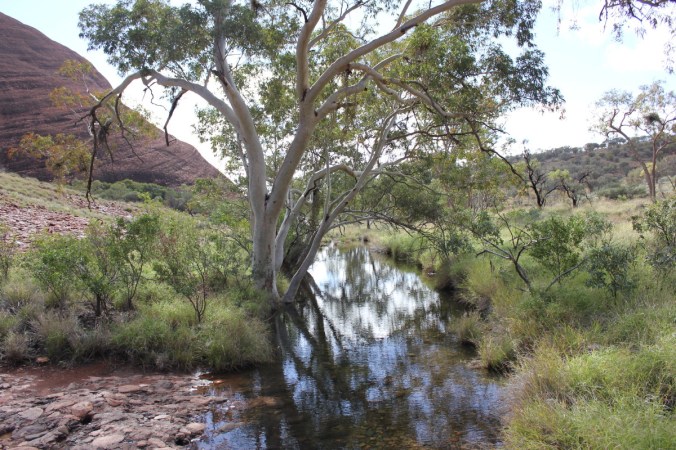 Lovely clear stream!
Lovely clear stream!
 These plants I have no idea at the moment what they are, they are a work in progress.
These plants I have no idea at the moment what they are, they are a work in progress.

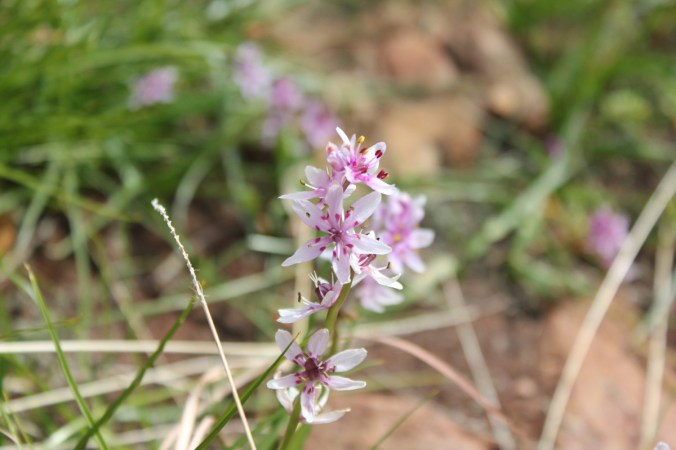 Pretty, never the less!
Pretty, never the less!

 In the above photo we are nearing the Karingana Lookout. You can see it in the distance, the high part in between the two walls. The walls of the domes just seemed to rise and rise into the bright noon day sun.
In the above photo we are nearing the Karingana Lookout. You can see it in the distance, the high part in between the two walls. The walls of the domes just seemed to rise and rise into the bright noon day sun. Well! We made it, what an amazing panorama greeted us!
Well! We made it, what an amazing panorama greeted us!

 Time to sit down for a quick bite to eat. The 3 oldest boys decided they would keep going on the circuit walk and us oldies along with our youngest lad turned back here. Here they are heading off at breakneck speed as per normal!
Time to sit down for a quick bite to eat. The 3 oldest boys decided they would keep going on the circuit walk and us oldies along with our youngest lad turned back here. Here they are heading off at breakneck speed as per normal!
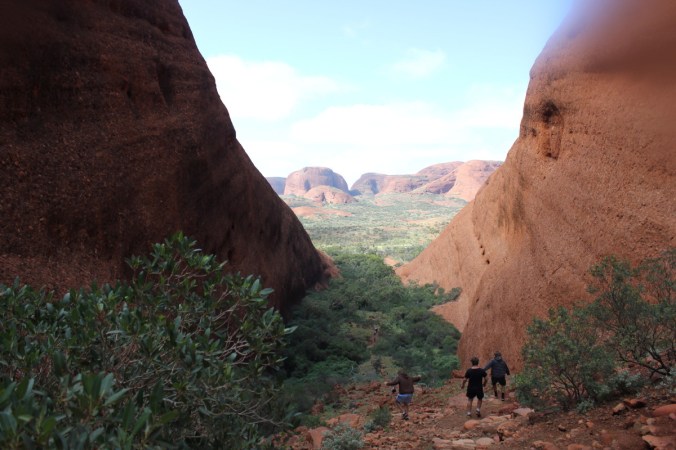 Below is another beautiful spot to recharge your batteries!
Below is another beautiful spot to recharge your batteries!

 Heading back to Karu Lookout. Below we have another Pussytail, Ptilotus exaltus , also known as Tall Mulla Mulla.
Heading back to Karu Lookout. Below we have another Pussytail, Ptilotus exaltus , also known as Tall Mulla Mulla.

 Grows to about 1.5 metres tall forming large showy drifts in open scrub and mulga country. The flowers start off cone shape then eventually lengthen to be elongated and cylindrical 3-20cm in length and 4.5cm in diameter. Compare the above two photos. The leaves are quite thick and rubbery looking, flowering from early spring until summer. Widespread across all mainland states. Here’s a small drift of them below.
Grows to about 1.5 metres tall forming large showy drifts in open scrub and mulga country. The flowers start off cone shape then eventually lengthen to be elongated and cylindrical 3-20cm in length and 4.5cm in diameter. Compare the above two photos. The leaves are quite thick and rubbery looking, flowering from early spring until summer. Widespread across all mainland states. Here’s a small drift of them below.

 Simply gorgeous!
Simply gorgeous!
Below is another plant that has featured in quite a few of these Northern Territory posts. Solanum quadriloculatum
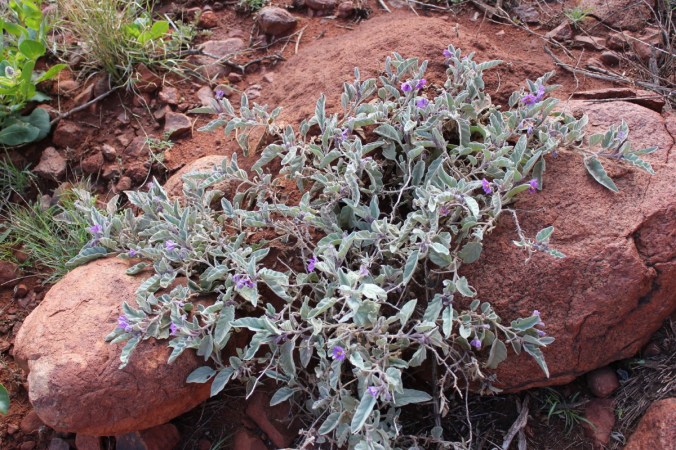 Another plant we saw was , Hakea subarea . This small tree also made an appearance at Ormiston Gorge. Click HERE if you can’t remember!
Another plant we saw was , Hakea subarea . This small tree also made an appearance at Ormiston Gorge. Click HERE if you can’t remember!
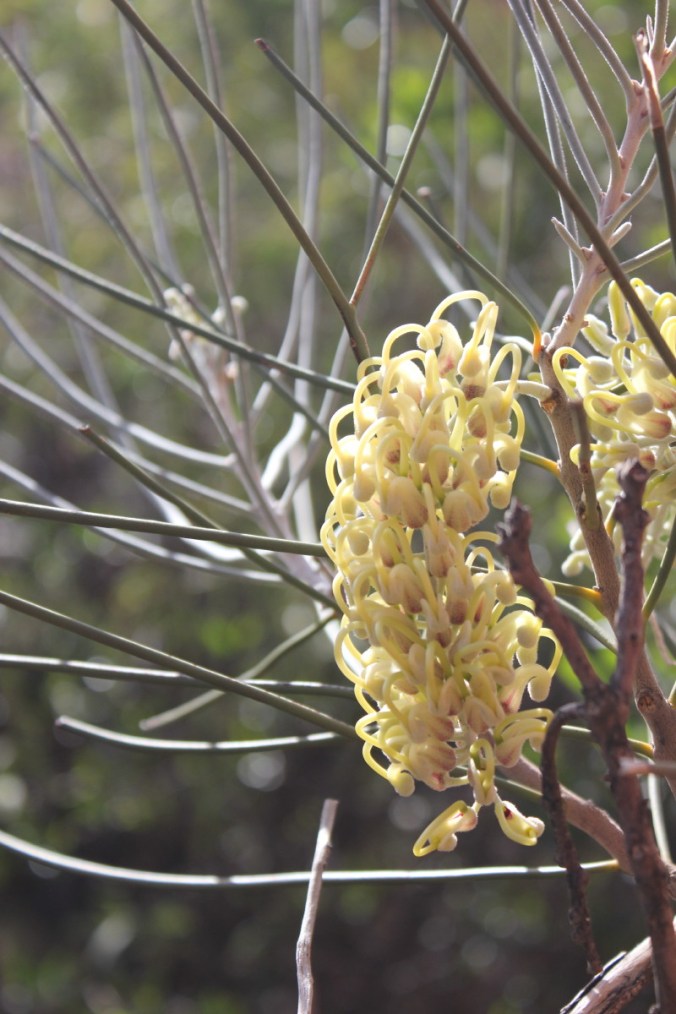 Here’s a beautiful Eremophila as well. Quite possibly Eremophila latrobei .
Here’s a beautiful Eremophila as well. Quite possibly Eremophila latrobei .

 Some walls for perspective! Note the little pocket of green three-quarters of the way up. Plants Hey! Amazing.
Some walls for perspective! Note the little pocket of green three-quarters of the way up. Plants Hey! Amazing.

More tall walls, this one below includes small people, well not small people, just normal ones!
 This is a small person one though!
This is a small person one though!
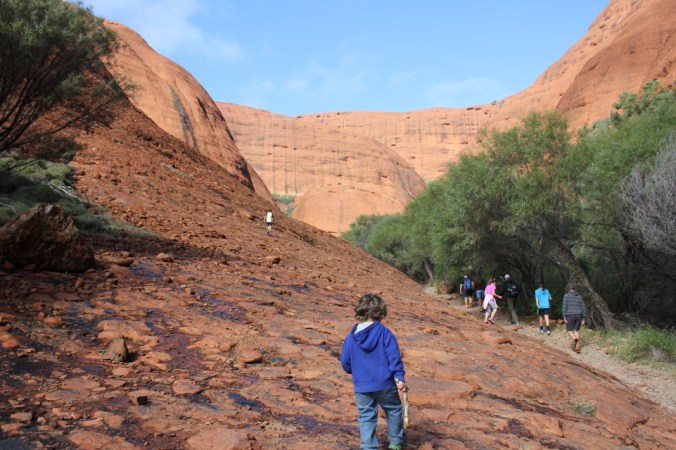 He’s also carrying a firearm( a gun I was told!).
He’s also carrying a firearm( a gun I was told!).

 Here are some more flowering meadows(for want of a better word) which were good to see.
Here are some more flowering meadows(for want of a better word) which were good to see.



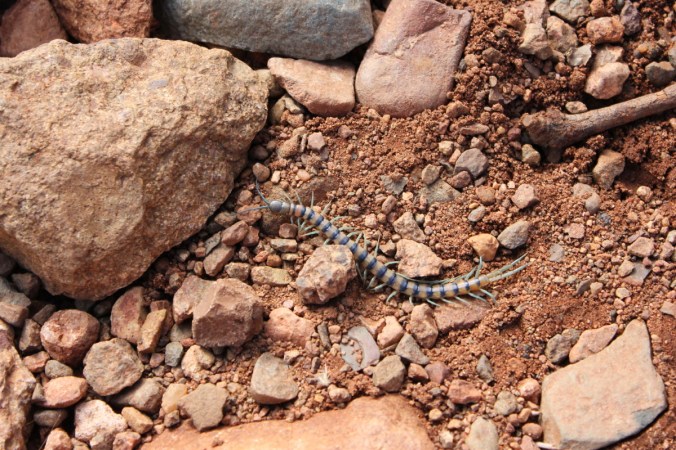 Oops! forgot about this little fellow. sorry!
Oops! forgot about this little fellow. sorry!
This plant below is Cattle bush or Camel bush. Yet again you see the need for scientific names!! Two common names for the same plant, not confusing at all! It is actually Trichodesma zeylanicum . A perennial plant growing to 1 metre occurring on rocky hills and sand dunes, stony alluvial soils or areas subjected to seasonal flooding, flowering in winter and spring.

 It was originally eaten by camels in the outback, hence one of its common names. One presumes then that cattle also ate or still eat it! Summer forage option! Here’s a few more random plant photos!
It was originally eaten by camels in the outback, hence one of its common names. One presumes then that cattle also ate or still eat it! Summer forage option! Here’s a few more random plant photos!
More stunning scenery!

Here’s one last plant I noticed when we had nearly finished the Valley of the Winds Circuit walk. I walked right past this on the way in! Go figure.
 Obviously a Brachyscome of some description, beautiful anyway.
Obviously a Brachyscome of some description, beautiful anyway.

 A nice sculpture below. The dead tree that is.
A nice sculpture below. The dead tree that is.
 Now we are nearly back to the start of this circuit walk. We did another small walk after this one but I will cover that next time round, i.e. part 12b! To finish off, I have added the below photos sans words as a parting gesture to the Valley of the Winds at Kata Tjuta. They speak for themselves!
Now we are nearly back to the start of this circuit walk. We did another small walk after this one but I will cover that next time round, i.e. part 12b! To finish off, I have added the below photos sans words as a parting gesture to the Valley of the Winds at Kata Tjuta. They speak for themselves!










 Cheers!
Cheers! I love how the branches radiate out from the trunk on this one. Native to Queensland, this evergreen coniferous tree can grow to somewhere between 30-45 metres. The Bunya Pine is the last surviving species in the section Bunya of the genus Araucaria. Fossils from section Bunya have been found in South America and Europe. This tree was around during the Jurassic.
I love how the branches radiate out from the trunk on this one. Native to Queensland, this evergreen coniferous tree can grow to somewhere between 30-45 metres. The Bunya Pine is the last surviving species in the section Bunya of the genus Araucaria. Fossils from section Bunya have been found in South America and Europe. This tree was around during the Jurassic.
 Leaves of the Bunya above, bark below.
Leaves of the Bunya above, bark below.
 That’s part of the Bunya Pine cone! Weighing in at an impressive 18 kg (roughly) and the size of a football. a hard hat may be called for if you decide to spend an extended amount of time under the Bunya. Living for about 500 years, the Bunya pine makes for an impressive looking tree in a weird sort of way!
That’s part of the Bunya Pine cone! Weighing in at an impressive 18 kg (roughly) and the size of a football. a hard hat may be called for if you decide to spend an extended amount of time under the Bunya. Living for about 500 years, the Bunya pine makes for an impressive looking tree in a weird sort of way!
 Next up we have the Atlas Cedar, Cedrus atlantica
Next up we have the Atlas Cedar, Cedrus atlantica Atlas Cedar is a Cedar native to the Atlas mountains in Morocco, reaching a height of 30-35 metre with a girth of up to 2 metres. Here is the bark with Lichen.
Atlas Cedar is a Cedar native to the Atlas mountains in Morocco, reaching a height of 30-35 metre with a girth of up to 2 metres. Here is the bark with Lichen. One of the smaller trees in this park is the Irish Strawberry Tree, Arbutus unedo . Can be either a large shrub or small tree, grows to about 10 metres and native to Mediterranean areas and parts of Ireland. It has white Erica like flowers that turn into large red berries, a bit like a strawberry! Here are its leaves.
One of the smaller trees in this park is the Irish Strawberry Tree, Arbutus unedo . Can be either a large shrub or small tree, grows to about 10 metres and native to Mediterranean areas and parts of Ireland. It has white Erica like flowers that turn into large red berries, a bit like a strawberry! Here are its leaves.
 Arbutus unedo is normally multi trunked. It was first described by
Arbutus unedo is normally multi trunked. It was first described by  The bark of the Irish Strawberry tree is quite remarkable as well.
The bark of the Irish Strawberry tree is quite remarkable as well.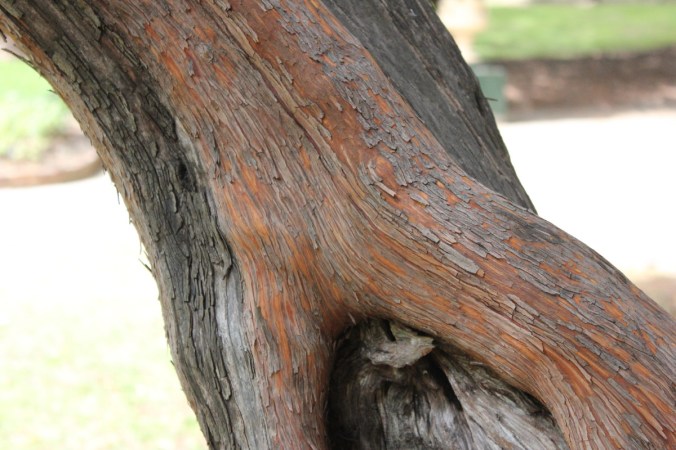 Another Cedrus here is Cedrus deodara, also known as the Deodar Cedar.
Another Cedrus here is Cedrus deodara, also known as the Deodar Cedar. Looks a bit like the Whomping Willow, don’t you think? Not that I’ve ever stood under the Whomping Willow, I just feel that this Deodar Cedar is tensing up its boughs to fling them around!
Looks a bit like the Whomping Willow, don’t you think? Not that I’ve ever stood under the Whomping Willow, I just feel that this Deodar Cedar is tensing up its boughs to fling them around! Bark above and cones below.
Bark above and cones below.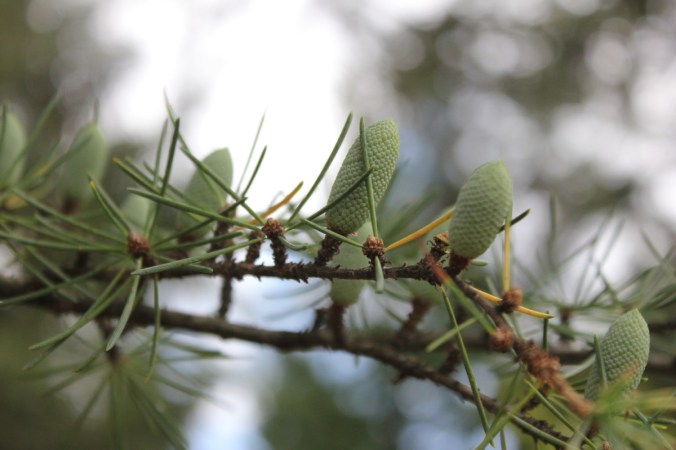 The Deodar Cedar is native to the Western Himalayas in Eastern Afghanistan through to Western Nepal. Grows to about 40-50 metres and occasionally 60 metres with a girth of up to 3 metres. This is also the national tree of Pakistan.
The Deodar Cedar is native to the Western Himalayas in Eastern Afghanistan through to Western Nepal. Grows to about 40-50 metres and occasionally 60 metres with a girth of up to 3 metres. This is also the national tree of Pakistan.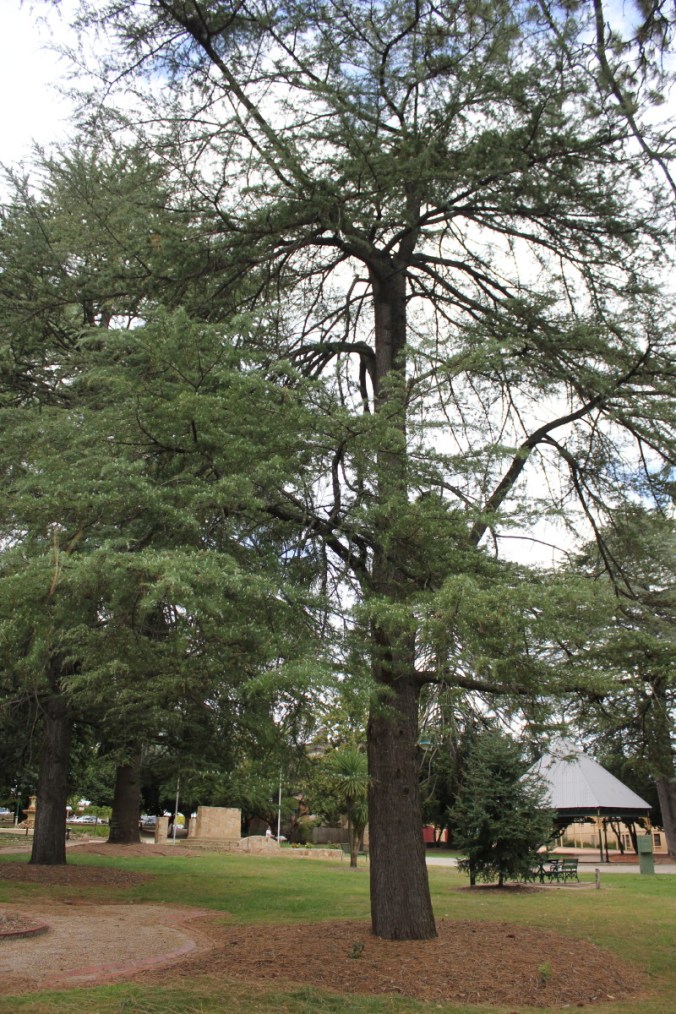 Next we have the Canary Island Pine, Pinus canariensis .
Next we have the Canary Island Pine, Pinus canariensis . Obviously native to the Canary Islands, this is a sub tropical pine which doesn’t like cold temperatures. Growing to about 30 – 40 metres but also able to reach 60 metres, with a girth of 2.5 metres. It has extremely long leaves which are needle like, see below.
Obviously native to the Canary Islands, this is a sub tropical pine which doesn’t like cold temperatures. Growing to about 30 – 40 metres but also able to reach 60 metres, with a girth of 2.5 metres. It has extremely long leaves which are needle like, see below. The bark is interesting as well.
The bark is interesting as well. Fun fact! “The tree’s long needles make a significant contribution to the islands water supply, trapping large amounts of condensation from the moist air coming off the Atlantic with the prevailing north-eastern wind (locally called “alisios”). The condensation then drops to the ground and is quickly absorbed by the soil, eventually percolating down to the underground aquifers”.
Fun fact! “The tree’s long needles make a significant contribution to the islands water supply, trapping large amounts of condensation from the moist air coming off the Atlantic with the prevailing north-eastern wind (locally called “alisios”). The condensation then drops to the ground and is quickly absorbed by the soil, eventually percolating down to the underground aquifers”. Lets have a look at the Western Yellow Pine, Pinus ponderosa . This pine hails from the Western United States and Canada and is the official state tree of Montana.
Lets have a look at the Western Yellow Pine, Pinus ponderosa . This pine hails from the Western United States and Canada and is the official state tree of Montana. Not sure where the top is in the above photo, in the wild one of these has been measured at 81.77 metres tall, now that’s tall! Check out its bark, that’s pretty cool too!
Not sure where the top is in the above photo, in the wild one of these has been measured at 81.77 metres tall, now that’s tall! Check out its bark, that’s pretty cool too!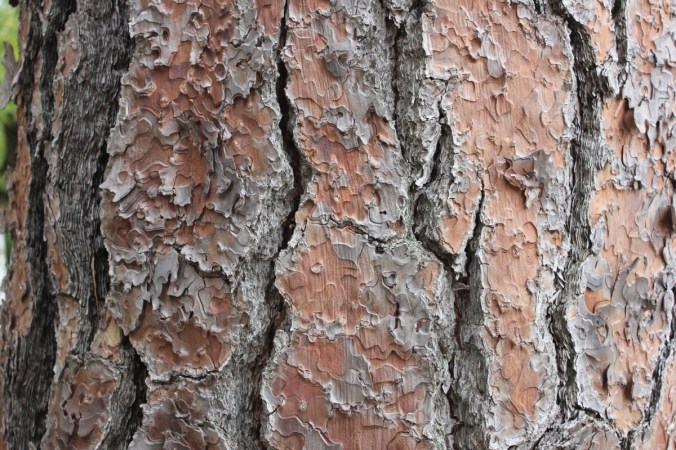 One more look at this tall tree.
One more look at this tall tree. Now, finally to the mummy or daddy of them all. Sequoiadendron giganteum . The Sierra Redwood. Although not the tallest tree in the world, that belongs to Sequoia sempervirens the coastal redwood, the Sierra Redwoods are the largest single tree’s and largest living thing (by volume) in the world. The biggest one, known as General Sherman is 83.8 metres tall with a girth of 31.3 metres at ground level. Yes, that’s not a typo! 31.3 metres at ground level. That’s a volume of 1,486.9 cubic metres!
Now, finally to the mummy or daddy of them all. Sequoiadendron giganteum . The Sierra Redwood. Although not the tallest tree in the world, that belongs to Sequoia sempervirens the coastal redwood, the Sierra Redwoods are the largest single tree’s and largest living thing (by volume) in the world. The biggest one, known as General Sherman is 83.8 metres tall with a girth of 31.3 metres at ground level. Yes, that’s not a typo! 31.3 metres at ground level. That’s a volume of 1,486.9 cubic metres!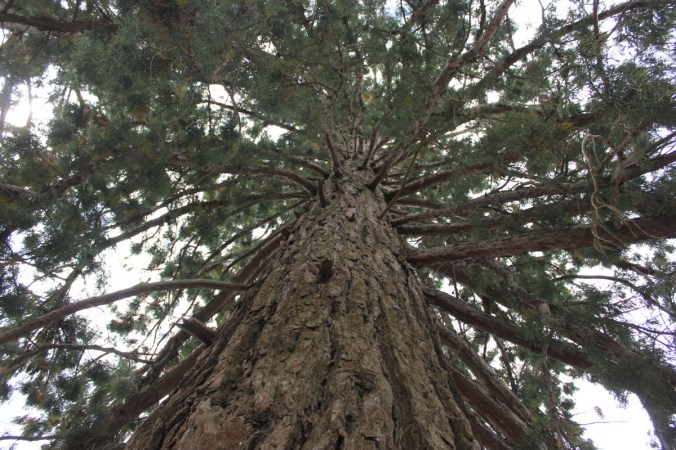 The bark can be up to 90cm thick, making it quite fire-proof. The oldest known Sierra Redwood is thought to be 3,500 years old.
The bark can be up to 90cm thick, making it quite fire-proof. The oldest known Sierra Redwood is thought to be 3,500 years old.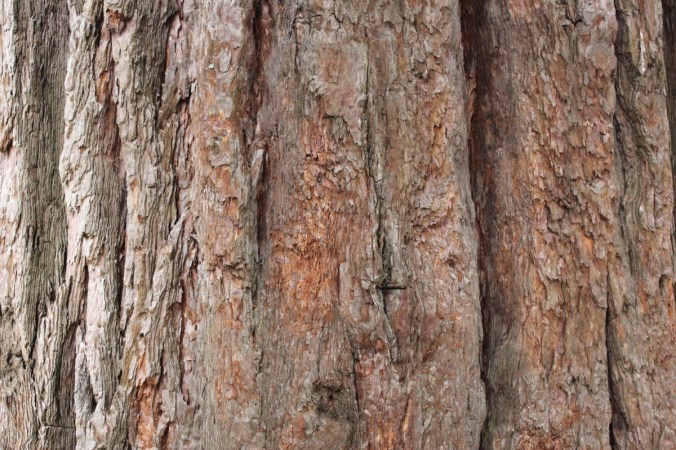 A large tree can have about 11,000 cones and surprisingly for such a large tree the cones are quite small. Here’s a collection that someone’s gathered.
A large tree can have about 11,000 cones and surprisingly for such a large tree the cones are quite small. Here’s a collection that someone’s gathered. As the name may suggest, this tree comes from the Sierra Nevada Mountains in California. Here’s a row of them below.
As the name may suggest, this tree comes from the Sierra Nevada Mountains in California. Here’s a row of them below.
 Here they are in their full glory
Here they are in their full glory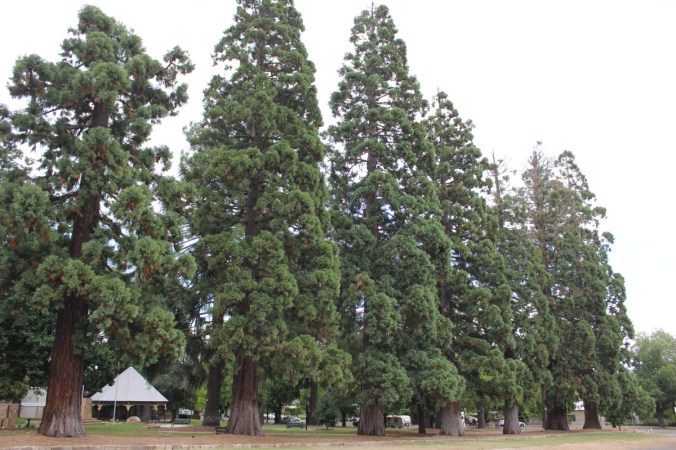 A couple more photos.
A couple more photos.
 To finish off, here is a small plaque in the gardens, nodding to the great botanist Ferdinand von Mueller, who had the foresight to donate these tree’s and seeds for future generations to enjoy, not only here but in many public gardens and Botanic gardens throughout the state. Thankyou!
To finish off, here is a small plaque in the gardens, nodding to the great botanist Ferdinand von Mueller, who had the foresight to donate these tree’s and seeds for future generations to enjoy, not only here but in many public gardens and Botanic gardens throughout the state. Thankyou!